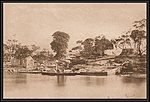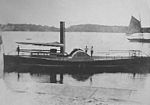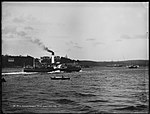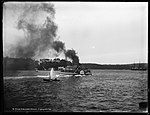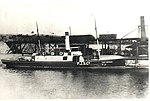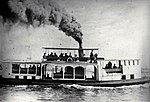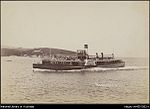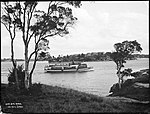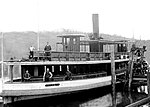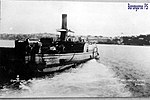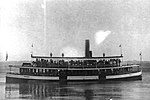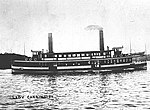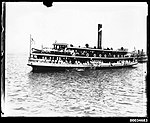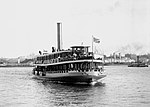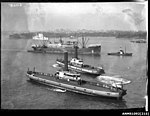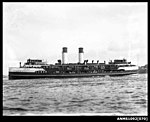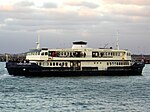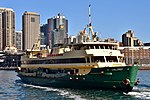List of Sydney Harbour ferries

Sydney Harbour's first ferries were sail and/or oar powered, but by the mid-19th century, paddle steamers were well established. Double-ended ferries became common as they did not require turning at terminating wharves in Sydney's busy but narrow bays, including at the main hub at Circular Quay. Double-ended ferries, however, provided technological challenges for screw (propeller) propulsion and Sydney's shift from paddle steamers to screw ferries in the closing years of the nineteenth century was relatively late. Diesel power first came to Sydney Harbour ferries mainly through the conversion of existing steam ferries to diesel in the 1930s and the 1950s, when during the slow post-Bridge decades ferry companies could generally not afford new ferries. Hydrofoils were introduced to the Manly run in the 1960s and 1970s halving travel times for those willing to pay a premium fare. Government investment in new vessels during the 1970s and 1980s saw the replacement of the surviving early twentieth century vessels. New vessels included modern Lady-class ferries, four large Manly ferries, and nine First-Fleet ferries. The most recent decades have seen the introduction of the RiverCats, JetCats, SuperCats and in 2017, the Emerald-class ferries. Apart from the four Manly "Freshwater-class" ferries, the current Sydney Ferries fleet comprises all catamarans.
| Name | Year built | Description | Origin of name | Tons | Length (m) | Passengers | Class/type | Out of service |
|---|---|---|---|---|---|---|---|---|
| Rose Hill Packet | 1789 | A hoy launched in 1789, in the year following the settlement of Sydney. Also known as 'The Lump', it was used to transport goods and passengers up the Parramatta River. The return journey could take a week between Sydney and Parramatta. | 12 tons (bm) | 11 m-13 m | Packet or Hoy | c.1800 | ||
| Surprise | 1831 | Launched in 1831 in Neutral Bay for the Parramatta service, Surprise was the first Australian built steamship and the first steam ferryboat in Sydney. In service for six months with limited financial success. Her draught was too deep for the route and she was sent to Tasmania. Sold to Hobart in 1832.[1][2] | 40 tons | 24 m | Paddle steamer | 1832 | ||
| Sophia Jane | 1826 |  |
38 m | Auxiliary steamer | ||||
| Experiment | 1832 | Due to high cost and difficulty in sourcing steam engines at the time, this vessel used horses on treadmill attached to a central wheel to propel her via paddle wheels. Provided a Sunday's-only service to Balmain from 1840. Converted to steam and in 1846 was sent to Brisbane to become that town's first ferry.[1][4] | Unusually had horses drive paddle wheels. | 38 tons | 24 m | 100 | Paddle steamer | 1846 |
| Australia | 1834 | Paddle steamer built for £200 by the newly-formed Australia Steam Conveyance Company for Parramatta service. 12 hp (9 kW) steam engines. With little opposition apart from sailing craft that struggled with river currents and tides, she was a financial success with the company paying a dividend in 1836 of 38 per cent. Withdrawn from Parramatta service following the introduction of Comet (1843) and used on Balmain, Five Dock, and Iron Cove runs.[1][4][5] | 45 tons | 25.3 m | Paddle steamer | 1863 | ||
| Rapid | 1837 | Second vessel ordered by the Australian Steam Conveyance Company following the success of Australia (1834). Built in the United Kingdom and sent to Sydney for re-assembly. The first double-ended ship in Australia. Copper boiler, 20 hp (14.9 kW) engine, iron hulled. Ninety-minute trip on Parramatta service. Ran aground at Glebe Point in 1863 where she was used as a house-boat.[1][4][6] | 1852 | |||||
| Kangaroo | 1840 | Paddle steamer built for Parramatta service. Bought in 1847 by Tasmanian Government for use in Hobart. Later worked in Melbourne until 1891.[1] | Australian native animal | 1847 | ||||
| Raven | Paddle steamer built for Parramatta service.[7] | Paddle steamer | ||||||
| Waterman | 1844 | Paddle steamer built for Parramatta service.[7] 8 hp engine. Began frequent services to Balmain run by Messrs Flood, Perdriau and Fennmore but the small ferry was unreliable and not popular. | 17 tons | 15 m | Paddle steamer | 1874 | ||
| William IV | Unusual style of paddle wheel.[8] | |||||||
| Emu | 1843 |  |
Australian native bird | 65 tons | 28.6 m | 150 | Paddle steamer | 1884 |
| Comet | 1843 | Wooden paddle steamer built by William Lowe in Clarencetown for Parramatta service. 35 hp triple expansion steam engine.[7] until bought in 1852 by syndicate that included Thomas Mort. Sold again the following year for £3,100 and transferred to Melbourne. Bought in 1862 and sent to New Zealand but sank en-route.[12] | 50 tons | 30.1 m | Paddle steamer | 1862 | ||
| Native | 1844 | Boiler exploded in 1850, renamed Maid of the Mill and later sold to Brisbane.[13] | 18.3 m | Paddle steamer | 1862 | |||
| Ferry Queen | 1844 | Built at 's yard at Pyrmont and used by brothers Thomas and James Gerrard to run from Windmill Street to Blues Point, the first regular cross-harbour ferry service. Also used to haul pints of produce and livestock.[14][15] | - | 8 tons | 40 | ? | ||
| Gypsy Queen | 1844 | Wooden paddle steamer built by Thomas Chowne, Pyrmont for Gerrard brothers.[14][15] | - | 8 tons | 40 | |||
| Brothers | 1847 |  |
Named after owners John and Joseph Gerrard.[10] | 50 tons | 20.6 m | 50 passengers | 1886 | |
| Cobra | 1849 | Iron paddle tug built in Swansea, South Wales. Designed as a tug-tender, she worked in Melbourne then Launceston, and then Hobart before working in Sydney from 1869. Her main Sydney role was a tug, and sometimes as a cargo vessel. On occasion, she would transport passengers to Manly. Transferred to Newcastle in 1874, and lasted until circa. 1917.[17] | 1874 to Newcastle | |||||
| Agenoria | 1850 | a Gerrard Brothers boat. Sold to Melbourne 1852.[14] | 22 tons | 15.8 m | 1852 | |||
| Victoria | 1851 | Iron paddle steamer. Built by Thomas Wingate & Co, Whiteinch, Scotland. 60 hp. Owned by E Manning from 1856 to 1863. She provides the first regular Manly service from 1856. Taken off Manly service 1860. Sold to Japan in 1863, sunk 1864. | 107 tons (1861, 132 tons) | 37.7 m (1861, 47.0 m) | 200 approx. | 1860 | ||
| Star | 1852 | Wrecked in 1857 | 44 tons | 22.3 m | 1857 | |||
| Mystery | 1852 | Wooden paddle steamer built by Money Wigram & Co, Northam, England. 60 hp 2 x grasshopper side lever steam engines by George Butchard. 9 knots. 60 hp 2 x oscillating steam engines. 11 knots. Imported by Manly Ferry Company to join Royal Alfred as a tug, cargo carrier, and excursion ferry. Converted to a lighter 1893 | 141 tons | 40.3 m | 750 | 1893 | ||
| Breadalbane | 1853 |  |
144 tons (1856: 161 tons) | 42.7 m (1856: 44.6 m) | 200 | 1883 broken up | ||
| Huntress | 1853 |  |
86 tons | 27.2 m | 1860 sold to New Zealand, wrecked 15 March 1872 | |||
| Black Swan | 1854 |  |
40 tons, 1865: 69 tons | 27.6 m, 1865: 33.5 m | 150 | Paddle steamer | 1868, wrecked | |
| Pelican | 1854 | Paddle steamer built for Parramatta service. Sister to Black Swan, similar to Emu. Also used to provide services to Manly. Sank 3 April 1888.[7][10][11] | 42 tons | 27.6 m | 165 | Paddle steamer | 1888 | |
| Herald | 1854 | A Gerrard Brothers boat, sent out in sections from England. Steered by a tiller at either end, she often worked as a tug. used her from 1871 to start a ferry service to Mosman Bay, and used on most runs across her career.[16][19] She sank off North Head in 1884 while waiting to tow a ship into the harbour.[14] | 22.9 m | 50 | 1884 | |||
| Premier | 1856 | 19 tons | 23.2 m | Paddle steamer | 1891 | |||
| Pearl (I) | 1856 | Iron paddle steamer, sister to Peri, lengthened in 1866. Built for S Crook and E Manning 13 hp 2-cylinder steam engine, re-engined 1866, 40 hp steam | 11 tons, 1866: 41 tons | 16.8 m, 1866: 31.0 m | Paddle steamer | 1891 | ||
| Peri | 1856 | 22 tons | 16.8 m | Paddle steamer | 1886 | |||
| Nautilus (I) | 1856 | a North Shore Ferry company vessel.[14] | 36 tons | 16 m | 1891 | |||
| Phantom | 1858 | Iron paddle steamer built in Melbourne by J Daw, most of her service was on Manly run for the Brighton and Manly Beach Steam Company. The first of the large double-ended Manly ferries. 50 hp steam engine. Also thought to be the first vessel in the long standing Manly ferry livery of dark green hull and white funnel with black topping. Long and narrow (beam 4.0 m) paddle steamer with shallow draft made for unpleasant rides across Sydney Heads in bad weather. Broken up in Pyrmont c. 1886[10][16] | 63 tons | 36.3 m | 160 | Manly ferry, paddle steamer | 1886 | |
| Ysobel | 1860 | Built by P.N. Russell & Co. Sydney. Joubert's first ferry, to Hunters Hill. Possibly Sydney's first screw-propelled ferryboat, however, there is no confirmation that it was not a paddle steamer.[20] | ||||||
| Kirribilli (I) | 1861 | A small double-ended wooden paddle steamer steered with a tiller at either end. Built by John Cuthbert, Sydney. 8 hp power steam engine. First ferry in .[14] Then transferred to be the second ferry on the Hunters Hill run. | Australian Aboriginal name meaning 'good fishing spot', and name of a Sydney suburb | 11 tons | 60 | 1879, wrecked | ||
| Cygnet | 1862 | 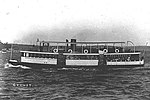 |
young swan | 30 tons | 27.1 m | Paddle steamer | 1891 | |
| Gypsy Queen | a Gerrard Brothers boat.[14] Took over from Waterman on the Balmain run in 1846. | |||||||
| Goolwa | 1864 |  |
191 tons | 39.6 m | Paddle steamer | 1876 | ||
| Emu (II), later Brightside | 1865 | Originally built in 1865 as Emu (II) by A & J Inglis, Glasgow and re-assembled at Kangaroo Point, Brisbane for use on Brisbane River and Moreton Bay. Originally owned by Queensland Steam Navigation Company. Came to Port Jackson Steamboat Company in January 1877 through to 1909. Renamed Brightside in 1887. Sank in 1897, converted to cargo vessel in 1902 and worked the Manly route until 1908 when she was gutted by fire. Converted to a lighter, and broken up in 1909.[14][22][23] | 269 tons | 52.1 m | 800 | Paddle steamer | 1908 | |
| Adelaide, later Swan | 1866 | 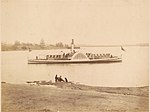 |
1900(?) | |||||
| Transit | 1866 | a North Shore Ferry company vessel.[25] | 69 tons | 24 m | ||||
| Galatea | 1868 | a North Shore Ferry company vessel.[14] | 21 m | |||||
| Royal Alfred | 1868 |  c. 1890 |
141 tons | 40.3 m | 750 | 1893 | ||
| Florence | 1872 | Wooden screw steamer built by W. Dunn, Lavender Bay. 8 hp steam engine by Chapman & Co. A North Shore Ferry company vessel.[14] Provided first regular daytime runs to Mosman. | 15 tons | 16.9 m | 1900 | |||
| Coombra | 1872 | a North Shore Ferry company vessel. Burnt out 1888.[14][21] | 45 tons | 23.8 m | 1888 | |||
| Leipoa | 1872 |  |
scientific name for Malleefowl | 49 tons | 27.4 m | 1918 | ||
| Aberona | 187? | Serviced the Mosman and Neutral Bay routes[19] | ||||||
| Bungaree (Beengaree) | 1873 | Horse punt | 61 tons | 23.7 m | (punt) | 1900 | ||
| Nautilus (II) | 1873 | Wooden screw steamer, built 1873 by W Dunn, Lavender Bay, for Parramatta River Steam Company. Ran a free service from along Tarban Creek to Hunters Hill wharf to meet river ferries.[26] Later North Shore Ferry Company, then Sydney Ferries Limited. 8 hp steam engine by Vale & Lacey. | 11 tons | 14.0 m | 75 | 1919, broken up | ||
| Glenelg | 1874 |  |
210 tons | 41.4 m | 1900, sank 25 March | |||
| Darra | 1875 | a North Shore Ferry company vessel.[14] | 57 tons | 24.9 m | 1883 | |||
| Nellie | 1877 | 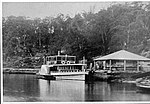 |
69 tons | 25.4 m | ? | |||
| Commodore | 1878 | Manly iron paddle steamer. Originally had twin funnels. Sold to Newcastle in 1926 for use as a tug. Scuttled 8 September 1931 | 187 tons | 1926 | ||||
| Victor | 1878 | a Gerrard Brothers boat.[14][28] | 24 tons | 15.8 m | ? | |||
| Nell | 1878 | a North Shore Ferry company vessel.[14] Wrecked 1883.[29] | 71 tons | 25.4 m | 1883 | |||
| Fairlight | 1878 | Paddle steamer on Manly run. Built in Scotland and sailed and paddled to Sydney. The third double-ended steamer on the Manly run and first to be specifically designed for the route. Converted to two lighters in Brisbane.[30][31] | A suburb near Manly. | 315 tons | 52.1 m | 950 | Manly ferry, paddle steamer | 1914. |
| Telephone | 1878 | Wooden paddle steamer. Built by H Perdriau. 40-hp compound diagonal steam engine by Atlas Engineering Co | 85 tons | 31.9 m | - | |||
| Wallaby | 1879 | Sydney's first double-ended screw ferry, and the second in the world. This remained the basic design of all Sydney double-ended screw ferries.[16] Unusually, lower deck passenger area was full width of hull with no bulwarks. Converted to a tug in 1918, then a lighter, and broken up in 1926.[14] | a native Australian animal | 163 tons | 32.9 m | 329 | - | 1918 |
| Osprey, later Lilac | 1879 | Screw steamer. Built as 'Osprey' in 1879 by W Dunn, Berry's Bay. 11 hp steam engine by Vale & Lacey. Sold to the North Shore Steam Ferry Co. in 1892 and renamed Lilac.[32] | 35 tons | 20.2 m | 200 | - | ||
| Benelon | 1880 | Wooden paddle steamer, double-ended vehicular ferry. Built in 1885 by David Drake Sunk in 1923 after collision with North Coast steamer Burringba without loss of passenger life, however, a number of horses went down with the ferry to much public outcry.[33] | Bennelong was a senior man of the Eora | 204 tons | 36.6 m | 28 vehicles, 84 passengers | Vehicular ferry | 1932. |
| Millie | 1880 | Wooden paddle steamer built by W Dunn at Berry's Bay. 25 hp steam engine by Mort's Dock and Engineering. Converted to a lighter 1902, broken up 1910 | 81 tons | 21.3 m | 1902 | |||
| St Leonards | 1880 | Paddle steamer, decommissioned in 1901 and used as floating pontoon at Neutral Bay and Hunters Hill[34] | a Sydney suburb | 110 tons | 33.5 m | 475 | - | 1901. |
| Alathea, Aleathea | 1881 | Built by Rock Davis. Both decks largely closed in. Sydney's first electrically lit ferry, and one of the first double-ended screw ferries. North Shore Steam Ferry company bought her from Parramatta River Steam and Tram Company. Travelling at 6.5 knots, she lost the 'forward' propeller and her speed immediately increased to 9 knots. 1892 re-engined (50 hp compound steam by Bow, McLachlan % Co) and converted to single-ended vessel with her lower deck closed in. Converted to lighter in 1913 and her engines placed in the Karingal launched that year.[5][35][36] | 79 tons, 1892: 120 tons | 33.3 m | 500 | 1913 | ||
| Defiance | 1881 |  |
64 tons | 25.2 m | 370 | 1888 | ||
| Rose | 1881 | Wooden screw steamer on Joubert's Lane Cove River service. Built by W Dunn, Berrys Bay, 12 hp steam engine. To Melbourne 1891, returned to Sydney 1898, burnt out 7 October 1916 | 43 tons | 20.4 m | 1916 | |||
| Lily | 1882 | Wooden screw steamer. Built J. Piper, Balmain, NSW. 20 hp triple expansion steam engine. Spent much of her time on the Circular Quay to Neutral Bay run.[37] Broken up 1911 | 66 tons | 23.0 m | 250 | - | 1911 | |
| Eagle, later Cygnet | 1882 |  As built, as Eagle |
74 tons | 23.9 m | 370 | - | 1931 | |
| Balmain | 1883 | Paddle steamer. Built by B.S. Bridges of Balmain for the Balmain Steam Ferry Company. From 1901, run by the Balmain New Ferry Company. Replaced by the second series of Lady class ferries and broken up around 1910.[38] | Sydney suburb | 117 tons | 36.5 m | Paddle steamer | 1910 | |
| Brighton | 1883 | Iron-hulled paddler. Built by T.B. Sheath & Co., Rutherglen, Scotland. A popular well-appointed Manly ferry. The largest paddle steamer ever operated on Sydney Harbour and the last on the Manly run. She was sold in 1916 becoming a store ship in Port Stephens.[31] Sunken hull remains in Port Stephens. | 67.1 m | 1200 | Manly ferry, paddle steamer | 1916 | ||
| Pearl (II) | 1883 | Wooden screw steamer on Joubert's Lane Cove River service. Built by J Piper for Lane Cove River service, Balmain for D & N Joubert. 10 hp steam engine. To Brisbane, 1883. Sunk in Brisbane River 13 February 1896. Hulk discovered on 19 February off Hancock Brothers Wharf, South Brisbane. Raised onto Peter's slip on Friday 6 March.[39] | 41 tons | 17.9 m | 360 | 1883, sank 1896 in Brisbane | ||
| Port Jackson | 1883 | Screw steamer used as Manly cargo vessel with passenger facilities. Could also be used as a tug.[31][40] | 108 tons | |||||
| Victoria | 1883 | Paddle steamer built by Watty Ford of Berry's Bay. Typical of the shape of North Shore Steam Ferry Company's double-ended paddle fleet. Incorporated into Sydney Ferry Company's fleet in 1900. Transferred to Melbourne about 10 years later.[41] | 119 tons | 34.1 m | 434 | 1910(?) to Melbourne | ||
| Warrane | 1883 | 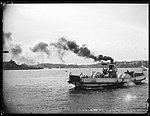 O/N: 83737[43][44] |
Australian Aboriginal name for "Sydney Cove" | 109 tons | 30.2 m | 14 vehicles, 144 passengers | Vehicular ferry | 1931 |
| Halcyon | 1884 | 82 tons | 30.2 m | 290 | 1933 | |||
| Gannet | 1884 | 48 tons | 19.8 m | 213 | 1930s | |||
| Cammeray | 1884 | Later used as floating pontoon and wharf.[34] | Cammeray is named after the Cammeraygal tribe | 197 tons | 39.3 m | 675 | 1908 | |
| Iris | 1884 | Wooden screw steamer. Cargo ferry lighter.[45] Built by J Lynch, Balmain for D & N Joubert. 10 hp compound steam engine by Alexander. Broken up 1928. | 35 tons | 18.3 m | 1928 | |||
| Pearl (III) | 1884 | Wooden screw steamer. Built by J Lynch, Balmain for D & N Joubert. 25 hp compound steam engine. Burnt in 1911, converted to houseboat, fate unknown. | 76 tons | 23.9 m | 1911 | |||
| Possum | 1884 | Wooden screw steamer. Built by Rock Davis, Blackwall. 12 hp steam engine by Chapman & Co. First all-night North Shore service. Sunk 1911 | 32 tons | 17.8 m | 1911 | |||
| Neutral Bay, later Thelma | 1885 | Renamed Thelma in 1897.[29] | A Sydney harbourside suburb | 50 tons | 21.0 m | 1920s | ||
| Bunya Bunya | 1885 | Typical of Sydney Harbour paddle steamer ferries, she was the largest and last of them. Sold in 1910 and used as a pontoon at Gladesville Bridge wharf. Sister to Waratah (II).[46][47] | Araucaria bidwillii, the bunya pine | 202 tons | 64.6 m | 688 | Paddle steamer | 1914 |
| Waratah (II) | 1885 | Paddle steamer. Later used as floating pontoon and wharf. Sister to Bunya Bunya.[34][47] | Australian-endemic genus of large shrubs including the NSW State floral emblem. | 197 tons | 36.6 m | 695 | Paddle steamer | 1910 |
| Ente | 1886 | Balmain paddle steamer | 117 tons | 36.5 m | 400 | |||
| Lincoln | 1886 | Balmain paddle steamer | 117 tons | 36.5 m | 400 | |||
| Leichhardt | 1886 | Balmain screw steamer | 68 tons | 23.1 m | 370 | |||
| Lotus | 1886 | Cargo vessel 1918-1939 | 70 tons | 22.6 m | 268 | 1918 | ||
| Narrabeen (I) | 1886 | Paddle steamer built by Mort's Docks for Port Jackson Steam Ship Company. Smaller and of lower passenger capacity than Brighton, she was used on off peak services to Manly.In 1911 she was modified for use as a cargo ferry with derricks fitted at either end. Hulked about 1917.[17] | Narrabeen | 239 tons | 48.8 m | Manly ferry | 1917 | |
| Swansea | 1887 | With Rose, provided the first regular Watson's Bay services.[48] | 60 tons | 359 | ||||
| Me Mel | 1888 | Paddle steamer built for Balmain Steam Ferry Company. On 31 January 1914, sank in four minutes without loss of life after being hit at her wharf by steamer Mokau. | 174 tons | 38.1 m | 580 | paddle steamer | ||
| Bee | Served the Watson's Bay run.[48] Unusually, had a canoe stern. Replaced by ex-Balmain ferry, Bald Rock, and sent to Brisbane. | |||||||
| Oceana | 1886 | Served the Watson's Bay run, wrecked on the bar of Manning River while en route to work for Manning River Ferry Company.[48][49] | 34 tons | 18.2 m | 240 | 1903 | ||
| Jenny Lind | Served the Watson's Bay run for the | |||||||
| Golden Rose | 1872 | Served the Watson's Bay run for the . Also served on early Mosman services in 1870s.[19] | 12 tons | 11.4 m | 1891 | |||
| Zeus | 1878 | Served on early Mosman services in 1870s.[19] Wrecked 1892 | 16 tons, 1898: 35 tons | 16.0 m | 1892 | |||
| Speedwell | Served on early Mosman services in 1870s.[19] | |||||||
| Matilda | Served on early Mosman services in 1870s.[19] | |||||||
| Mascotte | Served the Watson's Bay run for the | |||||||
| Elaine | 1882 | Served the Watson's Bay run for the . | 18 tons | 15.4 m | 310 | 1914(?) | ||
| Petrel | 1883 | Served the Watson's Bay run for the | 26 tons, 1898: 35 tons | 18.1 m | ||||
| Admiral | 1883 |  |
121 tons | 31.1 m | 1896, to New Zealand | |||
| Psyche | 1884 | 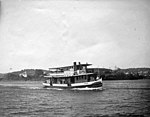 |
42 tons | 21.4 m | ||||
| Marra Marra | 1884 | One of several ferries in the early 1890s, used by the Manly Co-operative Steam Ferry Limited set up to compete, ultimately unsuccessfully, with the Port Jackson Steamship Company. | 66 tons | 25.3 m | 1896, to New Zealand | |||
| Victor | Served the Watson's Bay run for the | |||||||
| Bald Rock | 1884 | Wooden paddle steamer. Built in Balmain by G. Duncan for Balmain service.[46] 35 hp steam engine by Atlas Engineering Co. Renamed Vaucluse in September 1900. Later transferred to Watsons Bay service replacing Bee. Name reverted to Bald Rock in 1905. Sold to Melbourne 1907, broken up 1928. | location in Balmain | 105 tons | 34.3 m | Paddle steamer | 1907 | |
| Courier | 1887 |  Courier right side More images... |
65 tons | 22.8 m | 300 | |||
| Genista | 1886 | 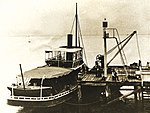 |
24.3 m | 200 | 1889 (to Victoria) | |||
| Pheasant | 1887 | First vessel on Sydney Harbour with triple expansion steam engines. Engines were later used in the Karrabee (1913),[35] and are now part of the Museum of Applied Arts and Sciences collection.[51] Converted to lighter, 1914–1918 | 138 tons | 33.5 m | 460 | 1914(?) | ||
| Birkenhead | 1888 | Balmain single-ended screw steamer. Had several owners and mostly used around the Balmain-Darling Harbour, Rozelle Bay areas. When the Balmain New Ferry Co. took over the Lane Cove run in 1906 the 'Birkenhead' was also used on that service to Fig Tree. Sank on 14 May 1913.[52] | 115 tons | 26.5 m | 440 | 1913, sank | ||
| Kangaroo (II) | 1891 | Wooden screw steamer built by David Drake Ltd, Balmain. 60 hp steam engine by Muir & Houston. First double-ended ferry with triple-expansion engines (by Muir & Houston). Burnt out in 1900 and in 1901 and rebuilt each time. Worked on North Sydney service before being transferred to Mosman service.[53] Sold for breaking up 1926. | Australian native animal | 158 tons | 34.1 m | 632 | K class | 1926 |
| The Lady Mary | 1892 | First of several series of 'Lady' ferries. Part of the Balmain New Ferry Company fleet until that company's takeover by Sydney Ferries Ltd in 1918.[54] Sold for £150 to Tay Lighterage Co in 1928 following drop in demand and cut backs to the Balmain service.[55] Became a houseboat after her service as a ferry.[46] | 79 tons | 25.3 m | 393 | Lady class, first series | 1928 | |
| Lady Napier | 1892 |  |
89 tons | 29.9 m | 450 | Lady class, first series | 1920 laid up(?) | |
| Lady Manning | 1893 | Part of the Balmain New Ferry Company fleet until that company's takeover by Sydney Ferries Ltd in 1918.[54] Sold for £100 to Tay Lighterage Co in 1928 following drop in demand and cut backs to the Balmain service.[55] | 97 tons | 33.2 m | 475 | Lady class, first series | 1928 | |
| Conqueror | 1893 | One of several ferries in the early 1890s, used by the Manly Co-operative Steam Ferry Limited set up to compete, ultimately unsuccessfully, with the Port Jackson Steamship Company. Later transferred to South Australia | ||||||
| Waringa Karaga | 1894 | Built by Dunn Brothers, for North Shore Steam ferries costing £3,068[42] and later taken over by Sydney Ferries Ltd for £2,400.[42] 30 hp compound steam engine by Muir & Houston Ltd, 11 knots. As built had open deck, which was glassed-in about 1910, renamed Karaga in 1913. Cost of additions thought to be £3,131.[42] Around 1919 was in use as the all-night steamer to North Sydney.[42] Taken out of service following opening of Sydney Harbour Bridge. Taken over by Australian government in 1943 for use as accommodation vessel.[57] | 125 tons | 32.2m | 588 | K class | 1943 | |
| Fearless | 1895 |  |
104 tons (1896 111 tons) | 34.1 m | 1932 | |||
| Barangaroo | 1896 | Vehicular paddle ferry. Sank off 1933 | Wife of Bennelong, a senior man of the Eora | 205 tons | 36.4 m | 26 vehicles, 86 passengers | Vehicular ferry | 1932 |
| Manly (II) | 1896 | Wooden screw steamer. Built by Young, Son & Fletcher, Balmain NSW. Designed by renowned naval architect Walter Reeks, the first double-ended screw ferry on the Manly run.[58] In 1922, set a record time of 22 minutes for trip to Manly which has not been beaten by conventional ferry (hydrofoils did the run in 15 minutes). Broken up in 1926 | 229 tons | 44.8 m | 820 | Manly ferry | 1924 | |
| Wallaroo Kiamala | 1896 | Wooden screw steamer. Built by Young, Son & Fletcher, Rozelle for £5,034.[42] Originally built with open upper deck and sister ship to Carabella.[47] 30 hp triple expansion steam engines by Muir & Houston Ltd. Originally operated by North Shore Steam Ferry Company then by Sydney Ferries Ltd (bought for £3,350).[42] Rebuilt in 1914 by David Drake, Balmain, NSW and glassed-in with named changed to Kiamala for and estimated cost of £1,505.[42] Taken out of service following opening of Sydney Harbour Bridge. Taken over by Australian government in 1943 to assist the war effort[59] as an accommodation vessel. Fate unknown | Wallaroo, Australian native animal. | 122 tons | 32.4 m | 545 | K class | 1943 |
| Lady Hampden | 1896 | Part of the Balmain New Ferry Company fleet until that company's takeover by Sydney Ferries Ltd in 1918.[54] Requisitioned for naval use in 1942. Sunk as target. | 135 tons | 35.1 m | 636 | Lady class, first series | 1942 | |
| Carabella Karabella | 1897 | Wooden screw steamer. Sister to Wallaroo/Kiamala.[47] Built by Young, Son & Fletcher, Rozelle for North Shore Steam Ferry Company (later Sydney Ferries Limited) 30 hp compound steam engine by Muir & Houston Ltd. Received electric lighting 1901. Rebuilt, extended, and renamed Karabella in 1916. On 9 May 1901, collided with Rosedale near Milsons Point and damaged amidships. On 17 January 1902, collided with Sonoma and sponson damaged. Taken out of service following opening of Sydney Harbour Bridge in 1932, however, in 1936 returned to service as an excursion vessel mainly following the 18 footer races. Returned to passenger service in 1939 on Neutral Bay route. Taken over by Australian government in 1943 to assist the war effort.[59][47] | After a house built on North Shore in 1882-'Carrably' | 129 t, 1916: 151 t | 32 m | 595 | K class | 1943 |
| Una | 1898 | Wooden screw steamer, built by WM Ford Jnr, Berrys Bay, 12 hp compound steam engine by Plenty & Sons, 9 knots. Built to replace Nautilus (II) on the Tarban Creek Run.[60] Burnt 4 April 1927 | Australian Aboriginal word meaning 'fancy name' | 44 tons | 20.6 m | 180 | 1927 | |
| Rose | 1898 | One of Joubert's Lane Cover ferries. Service speed of 10 knots. Designed well for river work with high wheelhouse to see over crowd and a good balance of open and closed areas. Burnt out on 4 April 1927 when Lane Cove service was near its end.[50] | 80 tons | 25.6 m | 1927 | |||
| Bronzewing | 1899 | Wooden screw steamer. The largest of Sydney single-ended ferries, she had a shallow draft and could exceed 12 knots. The last traditional 'river type' boat built for the Parramatta service. Glazed-in all around, and other open ferries were updated to match. Built by R. Young & Son, Balmain for £4,500.[42] 35 hp triple expansion steam engine by Ross & Duncan. 12 knots. Withdrawn from that service in 1931, used by Sydney Ferries Ltd until scrapping in 1933.[35][46] | a bird | 149 tons | 33.5 m | 500 | 1933 | |
| Kurraba | 1899 | Similar to Kirribilli (II). Built by North Shore Steam Ferry Co Ltd. Mainly used on the Mosman run.[61] Laid up 1932, sold for breaking up in 1934. | Sydney harbourside suburb | 195 tons | 40.9 m | 890 | K class | 1934 |
| Kirribilli (II) | 1900 | Wooden screw steamer. Similar to Kurraba. Served various North Shore runs. Retired following opening of the Sydney Harbour Bridge. Broken up 1935.[62] | Australian Aboriginal name meaning 'good fishing spot', and name of a Sydney suburb | 198 tons | 39.7 m | 896 | K class | 1934 |
| Kuring-gai (II) | 1901 | Designed by renowned naval architect, Walter Reeks. First of the familiar Manly ferry shape of the 20th century. Sold to Newcastle 1928. Tied up and hulked in 1934. In World War II, US forces used her in New Guinea as a storage barge. After WWII, towed back to Newcastle, moored at Hexham and sank in the mud near Hexham Bridge, still visible.[63] | Derived from the Guringai Aboriginal people who were thought to be the traditional owners of the area north of Sydney. More contemporary research suggests that this was not the case.[64][65][66] | 497 tons | 51.8 m | 1,228 | Manly ferry | 1928 |
| Kamilaroi | 1901 | 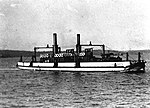 |
an Australian Aboriginal tribe | 328 tons | 39.0 m | 28 vehicles, 174 passengers.[46] | Vehicular ferry | 1932 |
| Shamrock | 1901 | Wooden screw steamer. Built by N Joubert. 20 hp compound steam engine by Ross & Duncan. 11 knots. Sold to Newcastle, renamed "Wattle". Broken up by 1941 in Lavender Bay, Sydney.[68] | 82 tons | 25.2 m | 420 | |||
| Koree | 1902 | Built by David Drake, Ltd, Balmain. First Sydney ferry with enclosed promenade deck passenger house. Sold for breaking up in 1934. | An Australian Aboriginal name for Chowder Bay | 276 tons | 42.8 m | 1,058 | K class | 1934 |
| Kailoa | 1902 | Wooden screw steamer. Built as Greyhound (II) as a tug in 1902 by Allen and Hunter. 33 hp compound steam engine by McKie & Baxter, 12 knots. Bought by Sydney Ferries Limited in 1908 for £6,473[42] and converted into a ferry to run the Clifton Gardens service. Reconverted to tug in 1917.[69] Broken up 1941.[70] | 1941 | |||||
| Kummulla | 1903 | Built by Dunn Brothers, North Sydney. Collided with Vaucluse in 1919 and was out of service for several weeks for repairs. In 1927, the first vessel to arrive and rescue passengers during the Greycliffe's sinking. Laid up following opening of Sydney Harbour Bridge, 1932. Engine removed 1935 and sold 1935. Hull sold 1939. | Australian Aboriginal word for 'catch me' | 168 tons | 36.3 m | 797 | K class | 1934 |
| Lady Rawson | 1903 | Part of the Balmain New Ferry Company fleet until that company's takeover by Sydney Ferries Ltd in 1918.[54] Differing to the other early Lady Class ferries, had open-air extended shelters for passengers on upper deck. Received significant damage when she collided with the Stephen Street Wharf Balmain on Christmas Eve 1908 and into the recently launched Kuranda (shortly to be renamed Kaludah).[71] Made redundant with the 1932 opening of the Sydney Harbour Bridge.[72] | 172 | 760 | Lady class, second series | 1934 | ||
| Vaucluse (II) | 1905 | Wooden double-ended screw steamer. Served the Watsons Bay run. The first of the Walter Reeks double-ended single-screw designs and built by Rock Davis of Brisbane Waters. At 15 knots, the fastest ferry at the time.[53][73][74] Expensive to run.[69] With the Watsons Bay run declining, the vessel was sold to Newcastle 1931 and its fate is unknown. Watsons Bay service was abandoned in 1933.[28][69] | a suburb in Sydney's east | 121 tons | 42.5m | 709 | 1931 | |
| Kulgoa | 1905 | Built by W M Ford Jnr, North Sydney. Along with Kuramia, at 338 tons, the largest wooden ferries on Sydney Harbour.[75] Built to service the busy North Shore routes. In 1935, provided with a higher (flying) bridge for use as a spectator vessel for sailing events.[76] Sold for breaking up 1952 following State Government takeover. | Australian Aboriginal word meaning 'returning' | 338 tons | 42.7 m | 1,255 | K class | 1952 |
| Binngarra | 1905 | Designed by Captain Christie and built by Morts Dock & Engineering. First of the Binngarra class Manly ferry that was the model for the Manly ferry throughout the 20th century. The first of six near identical sister ships Bellubera and Barrenjoey (later North Head).[77] Converted to lighter 1933 and used in Port Stephens. Hull later used in New Guinea by United States Navy during World War II. Scuttled 1946 | Australian Aboriginal word meaning 'returning' | 442 tons | 57.9 m | 1372 (summer) / 858 (winter) | Manly ferry, Binngarra type | 1933 |
| Lady Northcote | 1905 | Part of the Balmain New Ferry Company fleet until that company's takeover by Sydney Ferries Ltd in 1918.[54] First double-ended screw ferry in Sydney built for single-screw propulsion.[78] Converted to diesel power in the 1930s.[79] Similar to Lady Rawson but with raised wheelhouses. Along with Lady Rawson, was the largest of the series and sported two funnels. Sold and hulked 1941. Scuttled in Pittwater 1945 | Wife of Henry Northcote, 1st Baron Northcote | 128 tons | 35.3 m | 605 | Lady class, second series | 1941 |
| Kareela | 1905 | Built for Neutral Bay to Circular Quay Service by Morrison & Sinclair Ltd, Balmain. Nicknamed 'The Box'.[53] Sold for breaking up in 1959 after Kosciusko returned to service following her conversion to diesel power. | Australian Aboriginal word for 'south wind' | 106 tons | 34.4 m | 784 | K class | 1959 |
| King Edward | 1902 | Served the Watson Bay area until 1934,[53] and set new standards for speed and comfort.[73] Part of the Watsons Bay and South Shore Ferry Company which was bought by Sydney Ferries Ltd in 1920.[54] Sold in 1934 following the cessation of the Vaucluse service in 1933. | 98 tons | 31.1 m | 540 | 1934 | ||
| Lady Linda | 1906 | Part of the Balmain New Ferry Company fleet until that company's takeover by Sydney Ferries Ltd in 1918.[54] Was used more as a picnic boat than a ferry and ended her career as a small tug.[80] | 13 tons | 13.1 m | 1934 | |||
| Kaikai | 1906 | Built by David Drake Ltd, Balmain for £13,575.[42] Triple expansion steam engine (59 hp). When launched (7 November 1906 by Miss Nina Massic), she was the largest of the Sydney Ferries Ltd fleet. Reached 11.5 knots on her trials (13 March 1907), and three days later began work on the heavy-lift commuter run from Circular Quay to Lavender Bay.[81] Survived opening of harbour bridge in 1932 and was modified with a flying bridge to provide her master with greater visibility in order to follow yacht races. She was used extensively for charter and concert events. To Navy 1942 for use as accommodation ship.[59] Navy purchased her in 1943. Sold for breaking up 1947 O/N 121166[82][83] |
Australian Aboriginal word for 'jewfish' or 'food' | 303 tons | 46.3 m | 1245 | K class | 1942 |
| Ben Bolt | 1907 | Wooden screw steamer, built by George Whatmore, Bellinger River. Engine by Perdriau & West. 15 hp compound surface condensing steam engine. Later used as company cargo lighter by PJMS (1912-1923), then Harbour Land and Transport Co Ltd (1923-1932) Register closed 1932, fate unknown.[84][85] | 83 tons | 27.9 m | 1932 | |||
| Kookooburra | 1907 | Represented Sydney Ferries Limited's first attempt to design ferry specifically for Parramatta River service after it took over the service in 1901. Unusually for K class, it was originally fitted with a short funnel for service along the river and its low bridges.[86] Kaludah was smaller, but otherwise of similar design. Following cessation of services past Gladesville Bridge in 1928, she was fitted with tall funnel.[87] In late 1940s, was sent to Newcastle to carry dockyard workers. Broken up in 1959.[88] | Australian native bird | 180 tons | 42.7 m | 700 | K class | 1948-49(?) |
| Burra-bra | 1908 | Second of the Binngarra class Manly ferry. Almost identical sister ship to Binngarra (1905), Bellubera (1910), Balgowlah (1912), Barrenjoey (1913 – later North Head, and Baragoola. Sold to Navy in 1942. Broken up c. 1950.[89][90] | An Australian Aboriginal name for The Spit.[91] | 458 tons | 59.4 m | 1437 (summer) / 916 (winter) | Manly ferry, Binngarra type | 1942 |
| Lady Carrington | 1908 | Part of the Balmain New Ferry Company fleet until that company's takeover by Sydney Ferries Ltd in 1918.[54] Sold for breaking up 1934. | 146 tons | 39.6 m | 701 | Lady class, second series | 1934 | |
| Killara (II) | 1909 | Wooden screw ferry, double-ended vehicular ferry. Built by David Drake, cost £15,561.[42] 56 hp triple expansion steam engine by Mort's Dock & Engineering, 10 knots. sold for service on Westernport Bay in 1933 following the opening of the Sydney Harbour Bridge. Sold to Melbourne authorities 1944. Later broken up in Tasmania. Similar to Kedumba.[88][92] | 309 tons | 40.0 | 49 passengers, 33 vehicles | Vehicular ferry | 1933 | |
| Kaludah, formerly Kuranda | 1909 | Built by Morrison & Sinclair Ltd. Balmain. Campbell & Calderwood triple expansion steam engines (50 hp, 12 knots). Launched as Kuranda but named changed to Kaludah when larger ship was named Kuranda.[88] Of similar design to Kookooburra with short funnel to pass under low bridges on Parramatta River service.[86] Kookooburra and Kaludah were the only K-class ferries to have pointed rather than rounded ends. Gutted by fire and sank in 1911.[93]...the shortest lived of the Sydney ferries. Engines and usable timber went to the Kamiri.[77][94] | 137 tons | 35.1 m | K class | 1911 | ||
| Kanimbla (later Kurra-Ba) | 1910 | Similar to Kosciusko. Built by Morrison & Sinclair Ltd, Balmain. collided with Manly ferry Balgowlah tearing a hole in the Kanimbla's port bow. Balgowlah had minor damage whereas Kanimbla nearly sank. Gave up her original name, Kanimbla, in 1935 to a bigger ship, and became Kurra-Ba.[95] Broken up 1950s. | Australian Aboriginal word for 'Big fight' | 156 tons | 35.4 m | 791 | K class | 1946(?) |
| Bellubera More images |
1910 |  In her final configuration as a diesel-electric vessel |
Thought to be an Australian Aboriginal word for "pretty lady" or "beautiful woman".[96] | 499 tons (1936: 505 tons) | 64.0 m | 1,490 (summer)/962 (winter). (1936: 1,318) | Manly ferry, Binngarra type | 1973 |
| Kangoola | 1910 |  |
88 tons | 34.2 m | c. 1932 | |||
| Kirrule | 1910 | Identical sister to Kiandra & Kubu and otherwise similar to steel-hulled Kirawa and Kanangra. All three vessels survived the opening of the Sydney Harbour Bridge, but Kirrule and Kiandra were laid up following State Government takeover of Sydney Ferries Ltd in 1951.[99] She was considered for conversion to diesel, however, she was broken up in 1953. More images |
Australian Aboriginal word for 'aroused' | 258 tons | 42.7 m | 1100 | K class | 1951 |
| Lady Chelmsford | 1910 | Built by Brisbane Waters shipbuilder Rock Davis. Similar to Lady Edeline, Lady Denman, Lady Scott, and Lady Ferguson. Part of the Balmain New Ferry Company fleet until that company's takeover by Sydney Ferries Ltd in 1918.[54] In 1933, became first Sydney Ferries Ltd vessel to be converted to diesel. Gardner diesel, two strike five-cylinder providing 190 hp (141 kW) and 10.3 knots. Sent to Adelaide in 1971 and rebuilt as show boat. In 1985 moved to Melbourne where she sank in 2008 and was broken up in 2011.[100] | Wife of Governor of NSW, Frederic Thesiger, 1st Viscount Chelmsford | Lady class, third series | 1971 | |||
| Kiandra | 1911 | Built by Morrison & Sinclair Ltd, Balmain. Identical sister to Kirrule & Kubu. During the 1920s, Kiandra and her two sisters were used for harbour cruises and proved popular in this role.[101] Laid up immediately following State Government takeover of Sydney Ferries Ltd in 1951. Sold for breaking up 1953 | a corruption of Aboriginal 'Gianderra' for 'sharp stones for knives' and town in NSW | 258 tons | 42.7 m | 1,101 | K class | 1951 |
| Greycliffe | 1911 | Served the Watson's Bay run. Part of the Watsons Bay and South Shore Ferry Company which was bought by Sydney Ferries Ltd in 1920.[54] In 1927, sunk in collision with liner Tahiti with the loss of 40 lives. | 133 tons | 38.1 m | 1927 | |||
| Kosciusko | 1911 | Similar to Kanimbla. Built by David Drake Ltd., Balmain. Converted to diesel in 1959. In 1975, towed to Hobart following collapse of bridge and sold to that city. Following re-opening of the bridge, she was sold and used as a floating restaurant, but burnt out during renovations in 1982. End of hull, including propeller and rudder, displayed outside hotel in Hobart.[102][103] | Australian mountain named after Polish military leader Tadeusz Kościuszko | 165 tons | 35.4 m | 792 | K class | 1975 |
| Balgowlah | 1912 | Fourth of the Binngarra class Manly ferry. Steel double-ended screw steamer. Sister ship to Bellubera (1910), Barrenjoey (1913 – later North Head and similar to Binngarra (1905), Burra-bra (1908), and Baragoola (1922). Built by Mort's Dock & Engineering. 122 hp triple expansion steam engine by builder. 16 knots. Hulked 1953[89] | Name of Sydney suburb | 499 tons | 64.0 m | 1517 (summer) / 982 (winter) | Manly ferry, Binngarra type | 1953 |
| Kanangra | 1912 | Sister ship to Kirawa who were the first steel-hull K Class vessels. Built by Mort's Dock & Engineering Co. Ltd, Balmain. The last of the inner-harbour ferries to be converted to diesel re-entering service in 1959. Retired 1985. Now part of Sydney Heritage Fleet and under restoration. One of the longest serving Sydney ferries and the last of the large early twentieth century Sydney ferries. | Australian Aboriginal word for 'beautiful view' | 295 tons | 50 m | 1000 | K class | 1985 |
| Kirawa | 1912 | Sister ship to Kanangra who were the first steel-hull K Class vessels. Built by Mort's Dock & Engineering Co Ltd, Balmain. Retired and broken up in 1953 due to faulty boiler tubes.[104] | Australian Aboriginal word for 'looking for them' | - | 50 m | 1000 | K class | 1953 |
| Kubu | 1912 | Identical sister to Kiandra & Kirrule. Built by Morrison & Sinclair Ltd, Balmain. Along with her sisters, she was given greater power than earlier vessels of the same size so that longer runs to Mosman were quicker. Used in the 1920s as an excursion vessel. Removed from service following Kanangra's return to service after conversion to diesel. The last coal-fired steam ferry on Port Jackson. Laid up in 1959. | Australian Aboriginal word for 'oak tree' | 258 tons | 42.7 m | 1072 | K class | 1959 |
| Kamiri | 1912 | Sister to Kameruka. Built by Morrison & Sinclair Ltd, Balmain. Used engines and timbers of Kaludah which was gutted by fire in 1912. Retired in 1951 and broken up upon state government takeover of Sydney Ferries Ltd.[94][105] | Name of Aboriginal Australian tribe | 144 tons | 34.1 m | 594 | K class | 1951 |
| Lady Denman | 1912 | Built by J Dent of Jervis Bay. Similar to Lady Edeline, Lady Chelmsford, Lady Scott, and Lady Ferguson. Part of the Balmain New Ferry Company fleet until that company's takeover by Sydney Ferries Ltd in 1918.[54] Converted to diesel power in the 1930s.[79] Now part of museum on NSW South Coast. | Gertrude Denman, wife of fifth Governor-General of Australia | 96 tons | 33.5 m | 500 | Lady class, third series | |
| Antarctic | 1913 |  |
33 tons | 19.1 m | ||||
| Barrenjoey, later North Head | 1913 | Fifth of the Binngarra class Manly ferry. Almost identical sister ship to Binngarra (1905), Burra-bra (1908), Bellubera (1910), Balgowlah (1912), and Baragoola (1922).[89] Converted to diesel electric in 1951, and renamed North Head – significantly modified in appearance with two short funnels, enclosed top deck and new hull shape.[106] | Barrenjoey headland and Aboriginal word for wallaby. North Head at entrance to Sydney Harbour | 500 tons, 1954: 466 tons | 64.0 m | 1509, 1951: 1278 | Manly ferry, Binngarra type | 1985 |
| Kameruka | 1913 | Sister to Kamiri. Built by Morrison & Sinclair Ltd, Balmain for Parramatta River run. Relatively high speed ferry, and thus used on Taronga Zoo and river runs.[95] Burnt out in 1918 and rebuilt. 1938 boiler crowns collapsed and was not returned to work until 1945. In 1954 was converted to diesel and given a more modern-looking makeover.[105] One of the longest-lived Sydney Harbour ferries. | Australian Aboriginal word meaning 'wait til I come' | 144 tons | 34.1 m | 594 | K class | 1984(?) |
| Lady Edeline | 1913 | Built 1913, laid up 1984]] Built by J Watson of Annandale. Similar to Lady Denman, Lady Chelmsford, Lady Scott, and Lady Ferguson. Part of the Balmain New Ferry Company fleet until that company's takeover by Sydney Ferries Ltd in 1918.[54] Converted to diesel power in the 1936.[79] Re-engined 1963.[107] Laid up 1984, sank near Mortlake Punt 1988.[108] | 96 tons | 33.7 m | 544 | Lady class, third series | 1984 | |
| Karrabee | 1913 | Sister to Karingal. Built by Morrison & Sinclair Ltd. Original triple expansion steam engines (36 hp, Hawthorn, Leslie & Co.) were sourced from Pheasant (1887), Sydney's first triple-expansion steam ferry.[14] These engines are now part of the Museum of Applied Arts and Sciences collection.[51] 1936 converted from steam to diesel-electric power (6-cylinder diesel, by Henty & Gardner), the first of the Sydney Ferries Ltd fleet converted. Re-engined 1958. 1984 sank at Circular Quay after competing in the annual Great Ferry Race. Raised two days later and laid up. 1986 sold and relocated to Gosford as floating restaurant. Sank at wharf in 2003 and broken up in 2005. | Australian Aboriginal word for 'Cockatoo' | 107 tons | 32.8 m | 653 | K class | 1984 |
| Karingal | 1913 | Sister to Karrabee. Built by Morrison & Sinclair Ltd, Balmain. Her original steam engines came from Alathea when she was converted to a lighter.[36] Converted to diesel in 1937. Re-engined 1961. Sank in Bass Strait en route to new owners in Melbourne in the mid-1980s. | Australian Aboriginal word meaning 'happy home' | 107 tons | 31.7 m | 608 | K class | 1984(?) |
| Woollahra | 1913 | 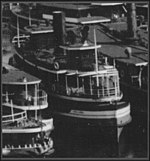 |
Australian Aboriginal word meaning 'camp', 'meeting ground' or a 'sitting down place' and the name of a Sydney suburb | 152 tons | 38.1 m | 1941 | ||
| Kuramia | 1914 | Along with Kulgoa, at 335 tons, the largest wooden ferries on Sydney Harbour.[75] Built by David Drake Ltd, Balmain. Engine sold 1940, requisitioned for naval use in 1942 as a boom gate vessel on the harbour boom off Watsons Bay.[59][54] Hulk sunk as target of Sydney, 10 October 1953. | 335 tons | 47.7 m | 1357 | K class | ||
| Kedumba | 1914 |  |
Australian Aboriginal word for 'falling water' | 294 tons | 40.1 m | Vehicular ferry | ||
| Lady Scott, later John Cadman | 1914 | Wooden screw steamer. Built by J Dent of Jervis Bay. Similar to Lady Edeline, Lady Chelmsford, Lady Denman, and Lady Ferguson. Part of the Balmain New Ferry Company fleet until that company's takeover by Sydney Ferries Ltd in 1918.[54] Converted to diesel power in the 1930s.[79][110] Sold in 1969 and converted to a cruise ferry. Caught fire and burnt to the waterline in 1972. Superstructure was rebuilt on hull with new appearance as the successful John Cadman cruising restaurant.[56] Sold 2000s renamed Harbour Queen. Sank at Blackwattle Bay 2014 and broken up | 95 tons | 33.5 m | 486 | Lady class, third series | 1969 | |
| Lady Ferguson | 1914 | Similar to Lady Edeline, Lady Chelmsford, Lady Scott, and Lady Denman. Part of the Balmain New Ferry Company fleet until that company's takeover by Sydney Ferries Ltd in 1918.[54] Converted to diesel power in the 1930s.[79] Re-engined 1956. Acting as a relief ferry since 1963, she was to set aside for disposal in 1974. Towed to Hobart in March 1975 as relief vessel after bridge collapse but could not be used due to poor condition. Broken up 1977.[56][107] | Lady Helen Hermione, wife of Ronald Munro Ferguson, 1st Viscount Novar | 96 tons | 33.5 m | 490 | Lady class, third series | 1975 |
| Kurnell, formerly Romantic | 1916 |  |
K class | 1942 | ||||
| Kooroongaba | 1921 | Vehicular ferry. Following opening of Sydney Harbour Bridge in 1932, used on the Hunter River between Newcastle and Stockton. Sank en route to Philippines 1972.[54] | Australian Aboriginal word for 'pelican' | 313 tons | 41.8 m | 45 vehicles, 220 passengers | Vehicular ferry | 1932 |
| Narrabeen (II) | 1921 | The last Manly cargo ferry. Nicknamed "The Broad Bean". Sold in 1928 to Westernport Bay Shipping Company when Manly cargo service closed down. Wrecked in 1958 | Named after Sydney suburb of Narrabeen | 235 tons | Cargo ferry | 1928 sold to Victoria, 1858 wrecked | ||
| Baragoola | 1922 | Steel screw steamer (later diesel). Sixth and final of the Binngarra class Manly ferry. Built by Morts Dock & Engineering.[89] Converted to diesel electric in 1961. Decommissioned 1983 and laid up. As of 2021, remains laid up at | Australian Aboriginal word for "Flood tide"[111] | 498 tons | 60.7 m | 1523 | Manly ferry, Binngarra type | 1983 |
| Kuttabul | 1922 | Along with her sister, Koompartoo, they were the last of the K-class ferries and the two largest ferries ever owned by Sydney Ferries Ltd. Built by NSW Government Dockyard, Newcastle. Passenger capacity larger than any Sydney ferry, including Manly ferries, both vessels built for the short heavy lift run from Circular Quay to Milsons Point. Originally certified for 1,505 passengers, they later carried up to 2,500 passengers, and regularly 2,000. Removed from service following opening of the Sydney Harbour Bridge. Later used for cruises and to view harbour sailing events. Taken over by the Royal Australian Navy as an accommodation ship and moored at Garden Island where, on 31 May 1942, sunk by Japanese torpedo with the loss of nineteen naval ratings (see Attack on Sydney Harbour). Naval base at Garden Island carries the name HMAS Kuttabul | Australian Aboriginal word for 'wonderful' | 447 tons | 55.7 m | 2089 | K class | 1932 |
| Koompartoo | 1922 | Built by NSW Government Dockyard, Newcastle. Along with sister Kuttabul, were the two biggest ferries ever owned by Sydney Ferries and the largest ferry on Sydney Harbour by passenger capacity. Both vessels built for the short heavy lift run from Circular Quay to Milsons Point. Made redundant on the Milsons Point run following 1932 opening of the Sydney Harbour Bridge and converted to concert boat in 1935. Converted to Naval boom-gate vessel 1942-42. Sold to Commonwealth Government 1945. Stripped hull went to Tasmania 1966 to be used as a bauxite barge.[112] | Australian Aboriginal word meaning 'a fresh start' | 447 tons | 55.7 m | 2089 | K class | 1932(?) |
| Koondooloo | 1924 | Originally built as a vehicular punt, in 1937, following redundancy with the opening of the harbour bridge, she was converted to be Sydney's first specially built showboat. In September 1942, she was converted to Army repair craft S181 Koondooloo adding workshops and gun sponsons.[38] Later, reconverted to a vehicular ferry. Wrecked at Trial Bay in 1972 while under tow.[54] | Australian Aboriginal word for 'emu' | 350 tons | 58.5 m | 56 vehicles, 292 passengers | Vehicular ferry | |
| Kalang, later Sydney Queen | 1926 | Steel steam screw vehicular ferry. Sister to Kara Kara and similar to Koondooloo and the biggest car ferries to operate in Sydney. Built by J Chrichton & Co Ltd (Saltney, England. 148 hp triple expansion steam engine by Plenty & Sons Ltd. 13 knots. Made redundant with opening of Sydney Harbour Bridge. Used as cargo vessel 1932-1938. Converted to a three-deck showboat 1938. In October 1942, converted to AEME floating workshop (repair ship) Kalang AB97. Steamed up Australian east coast and across to Samarai. Operated as repair ship in Rabaul and Torokina.[113] Converted back to show boat in 1947/48. Not included in the 1951 government takeover of Sydney Ferries and continued to operate as a showboat. Rising costs and decreasing business and sold and laid up in 1958. Renamed Sydney Queen in 1960 by new owners and painted white. Laid up in 1963. Wrecked at Trial Bay in 1972 while under tow to Manilla for use as a ferry/showboat.[54] | Australian Aboriginal word meaning 'beautiful' | 350 | 57.0 m | 50 vehicles, 250 passengers. 2,153 passengers as showboat | Vehicular ferry | |
| Kara Kara | 1926 | Vehicular ferry | Australian Aboriginal word for the moon | 350 | 57.0 m | Vehicular ferry | ||
| Estelle, later Estelle Star | 1927 | Wooden motor vessel built for N D Hegarty & Sons by G E Beattie, Woy Woy. 120 bhp diesel by Atlas Imperial Co, 8 knots. Built with open upper deck, enclosed prior to 1935.[114][115] Transferred to Victoria (1948? [116]). Converted to tuna trawler.[117] burnt out and/or sank 1976[118] or 1978[119] | 85 tons | 24.4 m | 400[120] | |||
| Curl Curl | 1928 | Along with Dee Why, one of two identical sister ships built for the Manly run. When introduced, the largest ferries on Sydney Harbour. Capable of 20 knots, possibly the fastest displacement hull ferry on Sydney Harbour. Laid up 1960, scuttled 1969.[121] | A suburb in Sydney's northern beaches. | 790 tons | 67.1 m | 1574 (summer) / 1235 (winter) | Manly ferry, Dee Why type | 1960 |
| Dee Why | 1928 | Along with Curl Curl, one of two identical sister ships built for the Manly run. When introduced, the largest ferries on Sydney Harbour. Laid up 1968, scuttled 1976.[121] | A suburb in Sydney's northern beaches. | 790 tons | 67.1 m | 1574 (summer) / 1235 (winter) | Manly ferry, Dee Why type | 1968 |
| Clifton | 1934 | Experimental ferry | ||||||
| South Steyne | 1938 | The largest and last steam ferry to operate on Sydney Harbour.[122] Built for the Manly run, she served until 1974. Damaged by fire 1974 while laid up, restored in the 1980s, used as a floating restaurant. Remains in existence and arguably the most famous of all Sydney ferries. | The southern promenade of Manly Beach | 1203 tons | 66.1 m | 1781 | Manly ferry | 1974 |
| Rodney Regalia | 1938 | Capsized on 13 February 1938 due to overloading of the top deck with the loss of 19 lives. Re-floated and renamed Regalia. | ||||||
| Kooleen | 1956 | New style, fully enclosed ferry. Originally intended to be the first of a series, she was immediately unpopular with passengers (but popular with masters) and no more were built. | 67 tons | 22.7 m | 278 | 1985 | ||
| Manly (III) | 1964 | Japanese built. The first hydrofoil service on Sydney Harbour | 31 tons | 20.7 m | 72 | Hydrofoil | ||
| Fairlight (II) | 1966 |  |
65 tons | 29.0 m | 140 | Hydrofoil | 1984 | |
| Lady Cutler | 1968 | First of new generation of double-ended ferries. Followed two years later by the similar Lady Woodward and Lady Mckell. | Helen Cutler, wife of Roden Cutler, Governor of NSW | 404 tons | 36.2 m | 570 | Lady-class ferry | 1991 |
| Palm Beach | 1969 | Hydrofoil on Manly service | Sydney beach and suburb | 65 tons | 29.0 m | 140 | Hydrofoil | |
| Lady Woodward | 1970 | Identical sister to Lady Mckell and near identical sister to Lady Cutler | wife of Eric Woodward Governor of NSW | 339 tons | 36.2 m | 570 | Lady-class ferry | |
| Lady Mckell | 1970 | Identical sister to Lady Woodward and near identical sister to Lady Cutler | 339 tons | 36.2 m | 570 | Lady-class ferry | ||
| Dee Why (II) | 1970 | Hydrofoil on Manly service | 65 tons | 29.0 m | 140 | Hydrofoil | 1985 | |
| Curl Curl (II) | 1973 | Hydrofoil on Manly service | 65 tons | 29.0 m | 140 | Hydrofoil | ||
| Lady Wakehurst | 1974 | In her original Public Transport Commission colours]]Sister to Lady Northcott. Sent to Hobart to assist following 1975 Bridge collapse. Returned 1977. Used on Manly run in 1970s and 1980s until new Freshwater class ferries commissioned. | wife of John Loder, 2nd Baron Wakehurst, former Governor of NSW | 366 tons | 38.9 m | 820 | Lady-class ferry | |
| Lady Northcott | 1974(?) | Sister to Lady Wakehurst | wife of John Northcott former Governor of NSW | 366 tons | 38.9 m | 820 | Lady-class ferry | 2018(?) |
| Lady Street | 1979 | Sister to Lady Herron | 350 tons | 35.3 m | 554 | Lady-class ferry | 2002(?) | |
| Lady Herron | 1979 | Sister to Lady Street | wife of Leslie Herron, Lieutenant Governor General of NSW | 350 tons | 35.3 m | 554 | Lady-class ferry | 2018(?) |
| Freshwater | 1982 | First of new class of Manly ferry. | Freshwater Beach | 1150 tons | 70.4 m | 1100 | Freshwater class | in service |
| Queenscliff | 1983 | Second of Freshwater class Manly ferry. Retired 13 October 2021.[123] | Queenscliff Beach | 1140 tons | 70.4 m | 1150 | Freshwater class | 2021 |
| Narrabeen (III) | 1984 | Third of original order of Freshwater class Manly ferry . | Narrabeen Beach | 1150 tons | 70.4 m | 1100 | Freshwater class | in service |
| Sirius | 1984 | First of nine "First Fleet-class" catamaran ferries. Each of the class underwent a major upgrade in 2020/21. | HMS Sirius, flagship of the 1787 First Fleet. | 105 tons | 25.4 m | 393 | First Fleet | in service |
| Manly (IV) | 1984 | 105 tons | 31.2 m | 235 | Hydrofoil | 1991 | ||
| Sydney | 1985 | 105 tons | 31.2 m | 235 | Hydrofoil | 1991 | ||
| Supply | 1985 | One of nine "First Fleet-class" catamaran ferries. Each of the class underwent a major upgrade in 2020/21. | HMS Supply, part of the 1787 First Fleet. | 105 tons | 25.4 m | 393 | First Fleet | in service |
| Alexander | 1985 | One of nine "First Fleet-class" catamaran ferries. Each of the class underwent a major upgrade in 2020/21. | 105 tons | 25.4 m | 393 | First Fleet | in service | |
| Borrowdale | 1985 | One of nine "First Fleet-class" catamaran ferries. Each of the class underwent a major upgrade in 2020/21. | More images... Borrowdale, part of the 1787 First Fleet. | 105 tons | 25.4 m | 393 | First Fleet | in service |
| Charlotte | 1985 | One of nine "First Fleet-class" catamaran ferries. Each of the class underwent a major upgrade in 2020/21. | Charlotte, part of the 1787 First Fleet. | 105 tons | 25.4 m | 393 | First Fleet | in service |
| Fishburn | 1985 | One of nine "First Fleet-class" catamaran ferries. Each of the class underwent a major upgrade in 2020/21. | Fishburn, part of the 1787 First Fleet. | 105 tons | 25.4 m | 403 | First Fleet | in service |
| Friendship | 1986 | One of nine "First Fleet-class" catamaran ferries. Each of the class underwent a major upgrade in 2020/21. | Friendship, part of the 1787 First Fleet. | 105 tons | 25.4 m | 403 | First Fleet | in service |
| Golden Grove | 1986 | One of nine "First Fleet-class" catamaran ferries. Each of the class underwent a major upgrade in 2020/21. | Golden Grove, part of the 1787 First Fleet. | 105 tons | 25.4 m | 403 | First Fleet | in service |
| Scarborough | 1986 | One of nine "First Fleet-class" catamaran ferries. Each of the class underwent a major upgrade in 2020/21. | Scarborough, part of the 1787 First Fleet. | 105 tons | 25.4 m | 403 | First Fleet | in service |
| Collaroy | 1988 | Fourth and final of Freshwater class ferry. First of its class to have open ends on upper deck. Preceding three Freshwater class ferries subsequently have the open upper deck retro-fitted. | Collaroy Beach | 1140 tons | 70.4 m | 1150 | Freshwater class | in service |
| Betty Cuthbert | 1992 | More images... | Athlete Betty Cuthbert | 41 tons | 36.8 m | 230 | RiverCat | in service |
| Dawn Fraser | 1992 | Swimmer Dawn Fraser | 41 tons | 36.8 m | 230 | RiverCat | in service | |
| Evonne Goolagong | 1992 | Evonne Goolagong | 41 tons | 36.8 m | 230 | RiverCat | in service | |
| Marlene Mathews | 1992 | Marlene Matthews | 41 tons | 36.8 m | 230 | RiverCat | in service | |
| Marjorie Jackson | 1992 | Marjorie Jackson | 41 tons | 36.8 m | 230 | RiverCat | in service | |
| Shane Gould | 1992 | Shane Gould | 41 tons | 36.8 m | 230 | RiverCat | in service | |
| Nicole Livingstone | 1995 | Nicole Livingstone | 41 tons | 36.8 m | 230 | RiverCat | in service | |
| Anne Sargeant | 1998 | netballer Anne Sargeant | 35 tons | 29.6 m | 150 | HarbourCat | in service | |
| Pam Burridge | 1998 | surfer Pam Burridge | 35 tons | 29.6 m | 150 | HarbourCat | in service | |
| Louise Sauvage | 2001 | Paralympian Louise Sauvage | 48 tons | 37.8 m | 250 | SuperCat | in service | |
| Mary MacKillop | 2001 | Australia's first declared saint Mary MacKillop | 48 tons | 37.8 m | 250 | SuperCat | in service | |
| Susie O’Neill | 2001 | swimmer Susie O'Neill | 48 tons | 37.8 m | 250 | SuperCat | in service | |
| SuperCat 4 | 2001 | - | 48 tons | 37.8 m | 250 | SuperCat | in service | |
| Fred Hollows | 2017 | Renowned ophthalmologist Fred Hollows | 40 tons | 36.4 m | 400 | Emerald class | in service | |
| Victor Chang | 2017 | Renowned cardiac surgeon Victor Chang | 40 tons | 36.4 m | 400 | Emerald class | in service | |
| Pemulwuy | 2017 | Aboriginal leader Pemulwuy | 40 tons | 36.4 m | 400 | Emerald class | in service | |
| Bungaree (II) | 2017 | More images... | Fred Hollows | 40 tons | 36.4 m | 400 | Emerald class | in service |
| May Gibbs | 2017 | Children's author May Gibbs | 40 tons | 36.4 m | 400 | Emerald class | in service | |
| Catherine Hamlin | 2017 | Obstetrician and gynaecologist Catherine Hamlin | 40 tons | 36.4 m | 400 | Emerald class | in service | |
| Me-Mel (II) | 2019 | Gadigal word meaning "eye" and name for Goat Island | 12 m | 43 | MiniCat | in service | ||
| Balmoral | 2021 | Sydney beach/locality[124] | Emerald class | |||||
| Clontarf | 2021 | Sydney suburb[125] | Emerald class | |||||
| Fairlight (III) | 2021 | Sydney suburb[126] | Emerald class | In service |
See also[]
Notes[]
- ^ a b c d e f Gunter (1978), p. 11
- ^ Prescott (1984), p 11
- ^ Andrews, Graeme (1982). A Pictorial History of Ferries: Sydney and Surrounding Waterways. Sydney: AH & AW Reed Pty Ltd. ISBN 0589503863.
- ^ a b c Andrews (1982), page 11
- ^ a b Prescott (1984), p. 58
- ^ Andrews (1975), p 115
- ^ a b c d e f g Gunter (1978), p. 12
- ^ Gunter (1978), p. 28
- ^ Andrews (1982), pp 11-12
- ^ a b c d e Gunter (1978), p 17
- ^ a b c Prescott (1984), p. 60
- ^ Andrews (1975), p. 115
- ^ Andrews (1982), p.12
- ^ a b c d e f g h i j k l m n o p q Gunter (1978), p. 14
- ^ a b Prescott (1984), p. 66
- ^ a b c d Gunter (1978), p. 71
- ^ a b Andrews (1982), p. 51
- ^ National Archives Australi
- ^ a b c d e f Gunter (1978), p. 23
- ^ Prescott (1984), p. 86
- ^ a b Prescott (1984), p. 62
- ^ Andrews (1982), p. 53
- ^ Prescott (1984), p. 64
- ^ Andrews (1982), p. 36
- ^ Gunter (1978), p. 16
- ^ City of Sydney Archives
- ^ City of Sydney Archives
- ^ a b Prescott (1984), p. 84
- ^ a b Prescott (1984), p. 77
- ^ Andrews (1982), p. 50
- ^ a b c Gunter (1978), pp 79-80
- ^ MAAS
- ^ "FERRY SMASHES HAVE BEEN FREQUENT". The Evening News. No. 18835. New South Wales, Australia. 4 November 1927. p. 15. Retrieved 14 November 2020 – via National Library of Australia.
- ^ a b c Gunter (1978), p. 76
- ^ a b c Gunter (1978), p. 13
- ^ a b Andrews (1975), p. 19
- ^ Museum of Applied Arts & Sciences. "Glass plate negative of steam ferry 'Lily' and HMS 'Nelson', Farm Cove, Sydney, 1882-8". Museum of Applied Arts & Sciences, Australia. Retrieved 21 April 2020.
- ^ a b Andrews (1982), p. 66
- ^ The Queenslander, 14 March 1896
- ^ Andrews (1982), p. 52
- ^ Andrews (1982), p. 38
- ^ a b c d e f g h i j k l m n "SYDNEY FERRIES". The Sun. No. 2853. New South Wales, Australia. 25 August 1919. p. 5. Retrieved 16 October 2021 – via National Library of Australia.
- ^ Appropriation Book
- ^ National Archives of Australia
- ^ City of Sydney archives
- ^ a b c d e Gunter (1978), p.72
- ^ a b c d e Prescott (1984), p. 85
- ^ a b c Gunter (1978), p. 33
- ^ Prescott (1984), p 78
- ^ a b Andrews (1982), p. 37
- ^ a b Museum of Applied Arts and Sciences
- ^ Museum of Applied Arts and Sciences
- ^ a b c d Andrews (1975), p. 30
- ^ a b c d e f g h i j k l m n o p q r s t u v Gunter (1978), p 78
- ^ a b Andrews (1994), page 89
- ^ a b c Andrews (1982), p. 93
- ^ Andrews, Graeme (1975). The Ferries of Sydney. A.H. & A.W. Reed Pty Ltd. p. 29. ISBN 0589071726.
- ^ Gunter (1978), p 21
- ^ a b c d Andrews, Graeme (1975). The Ferries of Sydney. A.H. & A.W. Reed Pty Ltd. p. 93. ISBN 0589071726.
- ^ City of Sydney Archives
- ^ Museum of Applied Arts and Sciences
- ^ Andrews (1982), p. 40
- ^ The Herald
- ^ Attenbrow, Val (2002). Sydney's Aboriginal past: investigating the archaeological and historical records. Sydney: UNSW Press. pp. 22–35. ISBN 9781742231167.
- ^ Aboriginal Heritage Office (2015). Filling A Void: A review of the historical context for the use of the word 'Guringai'. Sydney.
- ^ John, Morecombe (20 February 2015). "Misunderstanding: The historical fiction of the word Guringai that has filled a void in our knowledge of the original inhabitants". Manly Daily. Retrieved 23 September 2021.
- ^ "SYDNEY FERRIES". The Sun. No. 2853. New South Wales, Australia. 25 August 1919. p. 5. Retrieved 16 October 2021 – via National Library of Australia.
- ^ City of Sydney Archives
- ^ a b c Andrews (1982), p. 94
- ^ Prescott (1984), pp. 36, 67
- ^ "STILL THE POST OFFICE". The Sydney Morning Herald. No. 22, 135. New South Wales, Australia. 25 December 1908. p. 4. Retrieved 4 September 2021 – via National Library of Australia.
- ^ Andrews (1982), p. 100
- ^ a b Gunter (1978), p. 34
- ^ Prescott (1984), p. 35
- ^ a b Andrews (1975), pp. 93, 116, 117
- ^ ferriesofsydney.com
- ^ a b Gunter (1978), p. 73
- ^ Prescott (1984), p. 74
- ^ a b c d e Prescott (1984), p. 30
- ^ City of Sydney Archives
- ^ Andrews (1975), p. 92
- ^ Appropriation Books
- ^ UK National Archives
- ^ national archives.gov.uk
- ^ National Archives of Australia
- ^ a b Prescott (1984), pp. 15-16
- ^ Andrews (1982), p. 29
- ^ a b c Gunter (1978), p. 77
- ^ a b c d e Gunter (1978), p. 22
- ^ Prescott (1984), p. 61
- ^ Andrews (1982), p. 45
- ^ a b Prescott (1984), p. 70
- ^ "FIRE ON A FERRY ROAT". The Brisbane Courier. Queensland, Australia. 23 March 1911. p. 5. Retrieved 4 January 2020 – via Trove.
- ^ a b Andrews (1975), p. 59
- ^ a b Andrews (1982), p. 96
- ^ Morcombe, John (26 May 2019). "The Bellubera Had Its Fair Share of Controversies During Its Time". The Manly Daily. Retrieved 6 June 2019.
- ^ National Archives of Australia
- ^ UK National Archives
- ^ Andrews (1982), p. 104
- ^ "Vale Lady Chelmsford". Dockland News. Retrieved 27 April 2019.
- ^ Ferries of Sydney - Kiandra
- ^ Andrews (1982), p. 97
- ^ Prescott (1984), p. 71
- ^ Andrews (1982), p. 98
- ^ a b Prescott (1984), p. 37
- ^ Gunter (1978), p. 57
- ^ a b Prescott (1984), p. 73
- ^ smh.com.au
- ^ Andrews, Graeme (1975). The Ferries of Sydney. A.H. & A.W. Reed Pty Ltd. p. 31. ISBN 0589071726.
- ^ Gunter (1978), p. 62
- ^ savethebaragoola.com
- ^ Andrews (1975), p. 89
- ^ Andrews (1982), p. 65
- ^ City of Sydney Archives
- ^ City of Sydney Archives
- ^ City of Sydney archives
- ^ City of Sydney Archives
- ^ City of Sydney archives
- ^ Prescott (1984), p 64
- ^ City of Sydney archives
- ^ a b Prescott (1984), p. 63
- ^ Gunter (1978), p. 74
- ^ "First Freshwater class Manly ferry retired". ABC Radio. 13 October 2021. Retrieved 13 October 2021.
- ^ New ferries to be named after popular harbour beaches Transport for NSW 3 February 2021
- ^ New ferries to be named after popular harbour beaches Transport for NSW 3 February 2021
- ^ New ferries to be named after popular harbour beaches Transport for NSW 3 February 2021
References[]
- Andrews, Graeme (1975). The Ferries of Sydney. A.H. & A.W. Reed. ISBN 0589071726.
- Andrews, Graeme (1982). A Pictorial History of Ferries: Sydney and Surrounding Waterways. Sydney: AH & AW Reed. ISBN 0589503863.
- Gunter, John (1978). Across the harbour : the story of Sydney's ferries. Rigby. ISBN 0727007157.
- Prescott, AM (1984). Sydney Ferry Fleets. Magill South Australia: Ronald H Parsons. ISBN 0909418306.
- Andrews, Graeme (1994). Ferries of Sydney (Third ed.). Sydney: Oxford University Press / Sydney University Press. pp. 87–89. ISBN 0-424-00202-7.
- Ferry transport in Sydney
- History of Sydney
- Ferries of Australia
- Sydney-related lists
- Lists of ferries

